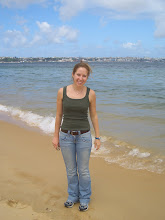 ^Me and my mad poison-dart frog-catching skills... explanation for that to come later.
^Me and my mad poison-dart frog-catching skills... explanation for that to come later. ^A typical trail at La Selva, although many trails are much narrower or and/or unpaved.
^A typical trail at La Selva, although many trails are much narrower or and/or unpaved.
 ^Golden orb spider. They're very common here, and their webs are stronger (can withstand more force/diameter) than steel.
^Golden orb spider. They're very common here, and their webs are stronger (can withstand more force/diameter) than steel.Our first day at La Selva was Costa Rica's independence day, so we spent the morning in town watching a parade. It was insanely hot, especially compared to the frigidness of Cuerici from which we had come. There were lots of school bands and dance groups, and I was especially impressed with the childrens' drumlines. It was fun watching the parade alongside the residents of Puerto Viejo, as we have had little interaction with Costa Rican people thus far.


Of course, during the first couple of days, we all took advantage of the hot weather and presence of the river to go swimming. At one point a few people swim "with" a cayman, although I was working at the time and unaware of the swimming escapade. A few of the guys subsequently decided to go back down to the river, essentially to stalk the cayman. Naturally, the cayman swam swiftly away upon sighting people - this after the guys spent a good half hour trudging down the densely forested, steep riverbank. It was a pretty hilarious sight to watch from the bridge above.

^Billy, Andrés, and Tim failing miserably at stalking the cayman.
During the early part of our stay here, we took a day trip to the local Dole banana plantation. We learned a lot about the history of bananas in Costa Rica (which we had studied previously in depth), the banana industry, and the process of growing and harvesting. The most entertaining parts, however, were probably a) Tim climbing up a ladder and trying to put a bundle of bananas in a bag and b) watching the mules pull trains of bananas through the plantation.

^Tim bagging a banana bunch.

^A mule pulling the "banana train."

^Boxing up bananas to go to Norway (yay!)
One cool aspect of the OTS abroad program is faculty-led projects, or FLP's. In our second week at La Selva, we had two of them. One was a study on the correlation between rates of herbivory, elevation, and plant diversity, and the other was about apogeotropic roots (roots that come out of the ground and climb up trees). Although I was in a group in charge of presenting the results of the herbivory study, my more adventurous/hilarious experience was a result of the apogeotropic roots study. In brief, we hypothesized that roots would tend to climb up trees with "nutrients funnels" - i.e., palm trees whose leaves capture falling leaves and create a "funnel" of nutrients from their decay. Throughout the project, we would occasionally trace these roots from the tree they were climbing to the tree from which they originated. This typically entailed digging in the ground to follow the root for a few meters at most. At the end of the day when I was working on the project, four of us (Claire, Becca, Tim, and myself) stayed behind to dig one last root to its source tree. We followed the root along and under the paved trail, only to discover about 45 minutes and about 20 meters later that it simply joined into a root that another group had dug previously but had abandoned as the root dove deep into the ground. After all of our efforts, though, we weren't about to give up on finding the source of the mega-root, and by this time the visiting professor who was in charge of the project was especially curious as to the source tree species. The four of us continued digging after the root, which after delving about a foot in the ground miraculously returned to a few inches below the surface. A few hours and FIFTY meters later, we traced the root straight to a huge tree of the Moraceae family. Both the tree and multiple sections of the root had the same milky latex, so we knew we hadn't taken a wrong turn along the way. Remarkably, that one root led to and climbed four different nutrient-funnel palms. By the time we finished, it was almost dark, and we were completely covered in mud and sweat... however, we still managed to sing our newly-learned (thanks to our professor) "Tropical Biology Blues" song all the way back to the dining room for dinner.

^Tim, Becca, and I digging away. Claire was playing photographer for the moment.

^SUCCESS!
Today is our last day at La Selva - we leave at 8 AM tomorrow morning - so last night a few of us went on a night hike, mostly with the intention of finding a fer-de-lance (highly poisonous snake that inhabits La Selva). Although we failed miserably at finding a fer-de-lance, we did manage to find a small slug-eating snake and a red-eyed tree frog. The red-eyed tree frog gave giraffes a serious run for their money for the position of Hilary's favorite animal... winner as yet undecided.

^Billy with red-eyed tree frog... AWESOME.

No comments:
Post a Comment